
 topics
topics
 download media
download media
 search
search
| Pre 1845 | 1845-1880s | 1890s-1910s | 1920s-1940s | 1950s-1990s | 2000s-Present |
Agricultural Hard Times 1920s-1940s












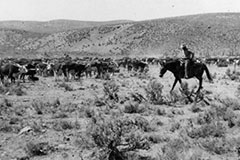

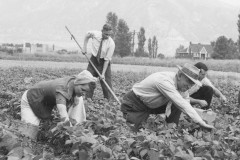

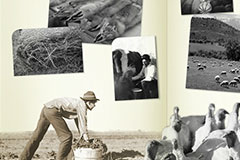



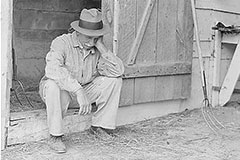

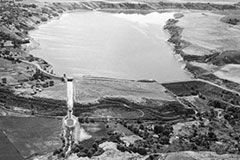

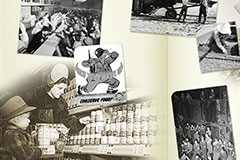

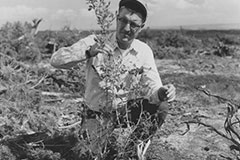


What would you like to find?

Downloadable Media: Agricultural Hard Times
Imagery









Video
Audio













During WWI, Utah's economy flourished and prospered. Demands for produce, sugar, beef, coal, and copper increased production during the war. Many Utahns planted "victory gardens," preserved food, and volunteered for work in the beet fields and on Utah's fruit farms.

The 1920s brought serious problems for Utah agriculture. Half of the 25,662 farms in the state were mortgaged because farmers and ranchers had borrowed money to expand them. Unfortunately, the end of World War I caused the demand and prices for Utah farm goods to drop. Over 5 million acres of farmland had been created but the average farm size fell to 197 acres. Farmers in the 1920s had to search for new cash crops. Increasingly, farmers planted sugar beets and row vegetables or produced milk for local canneries. Utah farmers also experimented with producing large quantities of alfalfa seed to sell. Some farmers tried their hand at fur farming by raising foxes, and later mink, for their pelts. Farmers in southern Utah began to raise turkeys or grow more melons to sell. All around the state farmers still depended on sheep and cattle for cash income. Overgrazing by the millions of sheep in Utah contributed to devastating floods in the 1920s and 30s.
During the first decades of the 20th century, sheep were the most important livestock in Utah in both numbers and value. In the 1920s, there were over 2.5 million sheep in Utah worth $23 million dollars. Utah, with its millions of acres of desert land, was an ideal region for raising sheep. Unfortunately, when the Great Depression hit in 1929, wool prices collapsed. On May 31, 1929, wool was selling at its highest price of $1.00 per pound, but after the depression hit, wool could barely fetch five cents per pound. Although the sheep industry would never fully recover after the depression, sheep have remained an important component in Utah's agricultural economy.

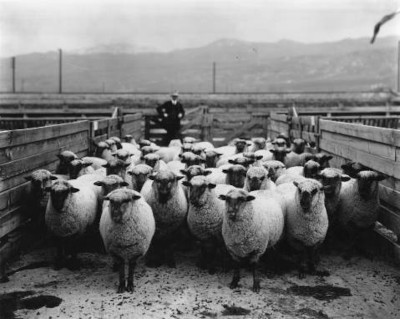
Sheep: The Ideal Foragers
An agricultural textbook from the early part of the century said this about sheep: "Sheep have no equal among the farm animals as foragers. They will eat a wide range of roughage, much of which is not of value to other stock. Certain weeds not palatable to most animals are eaten by sheep...Sheep will graze steep hillsides not accessible to horses or cattle, and will feed from the foliage and twigs of brushland pastures...Comparatively little labor is required in caring for sheep." The ability of sheep to thrive on almost any Utah landscape made them well-suited for many farmers. They could sell the wool and slaughter the sheep to sell for meat.


Sanpete County: The Heart of Sheep Country
By 1920, Utah had the largest number of Rambouillet (pronounced ram-boo-lay) sheep in the nation. This breed of sheep was large-framed and produced a lot of wool. Sanpete county was home to thousands of Rambouillet sheep, and because of its high, dry climate, abundance of grass, and excellent breeding program, Sanpete County proved to be an ideal place to raise sheep.
Questions
Why do you think sheep are still an important element in Utah's agricultural economy over a century later?
The Utah Department of Agriculture and Food is one of the oldest agencies in Utah. Today, it oversees dozens of legistatively mandated programs that promote the healthy growth of Utah Agriculture, the conservation of our natural resources, and the protection of our food supply.

In 1930 less than half of Utahns lived in rural areas. The agricultural problems of the 1920s became a crisis during the Great Depression. Prices for Utah livestock and crops plummeted, causing farm income to fall almost 60 percent. By mid-decade the number of farms in Utah, after reaching a high of 30,000, began to decline. In 1934 Congress passed the Taylor Grazing Act to restore damaged watersheds. Limits on grazing on public lands reduced the number of sheep in Utah by almost one million. Only the canning industry and the new frozen food industry held on. Economic disaster was followed by physical disaster. In 1934 Utah received the lowest amount of rain on record. The drought that followed was a catastrophe. Irrigation water was estimated as low as 15 percent of normal. Federal aid was arranged to try to save farmers. The Church of Jesus Christ of Latter-day Saints established a welfare plan, but over 25% of the rural families in Utah still ended up on federal relief during the 1930s.
The Great Depression spread across the country, and Utah was one of the hardest-hit states. Profits from Utah's industries dropped dramatically. Mine products plunged 80 percent; by 1932, farm income dropped from $69 million to $30 million. Farming communities struggled, and people living in small towns such as Smithfield (north of Logan) lived almost completely off of welfare. One farmer from Hooper said he could no longer afford fuel for his old Model T Ford, which prevented him from taking his eggs to market. This meant his chickens had almost no market value. The cows he purchased for $50 were now only worth $20.
The Utah Journey
During the Dust Bowl in the Great Plains, Utah was experiencing its own dust bowl in Grantsville due to a drought and overgrazing livestock in the Tooele Valley. Farmers and ranchers in Grantsville were experiencing the same struggles as those in the Midwest. Local soil conservation districts were established, and Utah's dust bowl area was re-seeded and irrigated. After years of patience and regrowth, the Tooele Valley was once again usable.

Dust Bowl: Grantsville, Utah
Watch this video about the Grantsville Dust Bowl and then answer the following question.
Questions
Why have we not experienced another dust bowl since the 1930s?
By 1932, the Great Depression had been affecting Americans for three years. The newest president, Franklin D. Roosevelt, promised Americans a "new deal of the cards." He worked with Congress to create programs that helped unemployed workers, farmers, and small business owners. These programs would bring relief, create jobs, and put a safer economic system in place. Some New Deal programs helped Utah farmers. The Farm Security Administration (FSA) gave long-term loans with low interest rates to small farmers. Not only were Utah farmers struggling through the Great Depression, they were also struggling through the fourth year of a drought. In 1934, Utah Lake had only one-third its usual amount of water, and Bear Lake was down 14 feet. Livestock were struggling and suffered when grass and watering holes dried up. Utah Governor Henry Blood asked the federal government for financial assistance, and officials sent an urgent telegram to the national Federal Emergency Relief Administration (FERA) asking for help. Within two days, President Roosevelt announced a grant of thousands of dollars to help Utah farmers. These funds were used to dig 276 wells, develop 118 springs, create 183 miles of irrigation ditches, and lay 98 miles of pipeline to carry water. As the drought continued, Governor Blood met with President Roosevelt and the Public Works Administration (PWA). Plans were made to make Deer Creek Dam in Heber City a priority. After this dam was built, water from the Provo River (and other rivers) was stored in this new reservoir. Eventually, dams were built in Sanpete County and at Moon Lake in the Uinta Mountains. Pineview dam and Hyrum dam were built with money from the federal government.
During the homesteading era, much of the western public rangelands were overgrazed due to policies promoting settlement in the west. Settlers lacked an understanding of how to maintain and care for these lands, so in response to western ranchers, Congress passed the Taylor Grazing Act of 1934. This led to the creation of grazing districts, and in each district, grazing was apportioned and regulated.

By 1940 there were more than 10 million acres of farmland in Utah but only 28,500 farms. The average farm size jumped to 354 acres. The 1940s brought war and the rationing of many foods. Food rationing and rising employment led to dramatic growth in the demand and prices for Utah farm goods. The demand for almost every agricultural product increased. However, the production of labor-intensive crops like sugar beets and row crops declined because so many workers were at war or working in factories. Farmers benefited from increasing mechanization during World War II, which made up for labor shortages. Women, Prisoners of War, and interred Japanese-American citizens all provided additional farm labor in Utah during the war. After the war, Utah agriculture experienced even greater growth as America went through a unique postwar boom.
Utah was involved in all aspects of the war. More than 71,000 Utahns left for service in the armed forces. Utahns also gave support at home. Thousands of women found jobs in manufacturing and other businesses after the men went off to fight. Their efforts helped both the soldiers abroad and people at home. People everywhere were determined to work hard and win the war as quickly as possible. For example, any person who grew 3,000 or more chickens could stay at home to produce food. During WWII people could only buy so much sugar, meat, butter, coffee, gas, and tires. Families were given ration stamps for these items every month. When the stamps ran out, familes had to wait until the next month to buy more.


Helping the War Effort
"Every person who grew 3,000 or more chickens could stay home to produce food. Well, I had 12,000 chickens. I worked very hard, but I didn't mind it because of two reasons...Hitler [the leader of Germany] was my....enemy, and I was blessed that I could stay at home and raise enough eggs to care for the troops." -Harry Isadore Smith
The Utah Journey

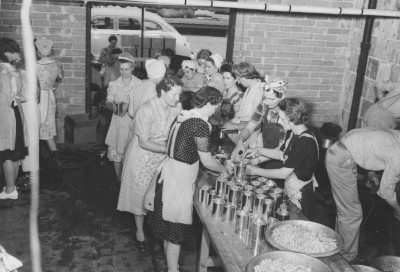
Victory Canning
During wartime, the government encouraged both home gardens and home canning. Families were encouraged to grow "victory gardens" as a way to supplement their food supply. A January 1943 poll showed that 75 percent of Americans processed food at home. Food preservation was important during the war years. In fact, Utah still leads the nation today in per capita home canners.
Questions
What are other methods of preserving food? If we were asked to conserve food today, which foods do you think should be rationed? Why?


The War Effort at Home
World War II greatly changed farm life and society in Utah. By 1940 less than 45 percent of Utahns were living in rural areas. Read The War Effort at Home by John D. Barton and consider the effects WWII had on Utah families.
Questions
How were farmers and their families affected by the war? What happened to the men who worked on the farms? How did women's roles on the farm and in Utah in general change after the war?
The Bureau of Land Management (BLM) was created in 1946 and is one of four federal land agencies that manages and maintains 600 million acres of federal land in the United States. Today, the BLM in Utah manages almost 23 million acres (42% of the state's land area) for various uses. Ranchers in Utah utilize BLM land to graze sheep and cattle. These ranchers own their own land, but also pay an annual fee to the government for grazing permits which allows livestock to graze public lands. In addition to recreation and ranching, the lands managed by the BLM also include ancient rock art, early homesteads, and historic immigration and trade routes.



